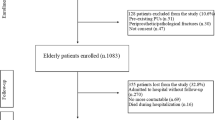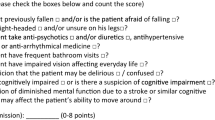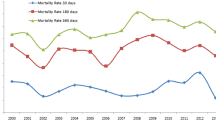Abstract
Background and aims: The study investigates one-year mortality risk associated with hip fracture in elderly people, and pre-fracture characteristics and events occurring during the acute phase which may represent significant predictors for acute and long-term mortality. Methods: The study is a prospective cohort study of 252 patients aged 70 and older, consecutively admitted with hip fracture to the Division of Orthopedic Surgery of the Galliera Hospital of Genoa, Italy. At admission, each subject received a standardized diagnostic evaluation, including demographic variables, biochemical markers of nutritional status and basic medical, functional and cognitive assessment. Patients were followed by telephone interviews at three months, six months and one year after fracture. The relationship between mortality and the risk factors recorded was assessed using logistic regression models. Results: 248 patients were eligible. Cumulative mortality was 4.8% during hospital stay, and 12.5% at 3, 18.9% at 6 and 24% at 12 months. The risk factors significantly associated with mortality were: sex, Acute Physiology Score (APS), comorbidity, functional and cognitive status, and albumin levels. In multivariate models, albumin below 3 g/dL remained the only significant predictor of in-hospital mortality (OR 6,8, 95% CI 1.56-29,7, p<0.001); functional status and comorbidity were significant risk factors of mortality after 6 and 12 months. Conclusions: These findings confirm the important role of serum albumin in assessing in-hospital health status and defining its role as a strong predictor of early and late mortality after hospital discharge. They also emphasize the effects of comorbidity and functional impairment on long-term mortality after hip fracture. Identifying these predictive factors may be helpful in improving case management during hospital stay and more accurate discharge planning.
Similar content being viewed by others
References
Empana JP, Dargent-Molina P, Bréart G. Effect of hip fracture on mortality in elderly women: The EPIDOS Prospective Study. J Am Ger Soc 2004; 52: 685–90.
Jarman B, Aylin P, Bottle A. Discharge destination and length of stay: differences between US and English hospitals for people aged 65 and over. Br Med J 2004; 328: 605.
Zuckerman JD. Hip fracture. N Engl J Med 1996; 334: 1519–25.
Roberts SE, Goldacre MJ. Time trends and demography of mortality after fractured neck of femur in an English population. 1968–98: database study. Br Med J 2003; 327: 771–5.
Koval KJ, Skovron ML, Aharonoff GB, Zuckerman JD. Predictors of functional recovery after hip fracture in the elderly. Clin Orthop 1998; 348: 22–8.
Magaziner J, Simonsick EM, Kashner TM, Hebel JR, Kenzora JE. Predictors of functional recovery one year following hospital discharge for hip fracture: A prospective study. J Gerontol 1990; 45: M101–7.
Cooper C, Campion G, Melton LJ 3rd. Hip fractures in the elderly: a world-wide projection. Osteoporos Int 1992; 2: 285–9.
Lyons AR. Clinical outcomes and treatment of hip fractures. Am J Med 1997; 103: 51S-64S.
Schroder HM, Erlandsen M. Age and sex as determinants of mortality after hip fracture: 3895 patients followed for 2.5–18.5 years. J Orthop Trauma 1993; 7: 525–31.
Clague JE, Craddock E, Andrew G, Horan MA, Pendleton N. Predictors of outcome following hip fracture. Admission time predicts length of stay and in-hospital mortality. Injury 2002; 33: 1–6.
Marcantonio ER, Racker JM, Michaels M, Resnick NM. Delirium is independently associated with poor functional recovery after hip fracture. J Am Geriatr Soc 2000; 48: 618–24.
Myers AH, Robinson EG, Van Natta ML, Michelson JD, Collins K, Baker SP. Hip fractures among the elderly: factors associated with in-hospital mortality. Am J Epidem 1991; 134: 1128–37.
Zuckerman JD, Skovron ML, Koval KJ, Aharonoff G, Frankel VH. Postoperative complications and mortality associated with operative delay in older patients who have a fracture of the hip. J Bone Joint Surg Am 1995; 77: 1551–6.
Orosz GM, Magaziner J, Hannan EL, et al. Association of timing of surgery for hip fracture and patient outcomes. JAMA 2004; 291: 1738–43.
Grimes JP, Gregory PM, Noveck H, Butler MS, Carson JL. The effects of time-to-surgery on mortality and morbidity in patients following hip fracture. Am J Med 2002; 112: 702–9.
Aharonoff GB, Koval KJ, Skovron ML, Zuckerman JD. Hip fractures in the elderly: predictors of one year mortality. J Orthop Trauma 1997; 11: 162–5.
Diamond TH, Thomley SW, Sekel R, Smerdely P. Hip fracture in elderly men: prognostic factors and outcomes. Med J Aust 1997; 167: 412–5.
Poor G, Atkinson EJ, O’Fallon WM, Melton LJ 3rd. Determinants of reduced survival following hip fractures in men. Clin Orthop 1995; 319: 260–5.
Koval KJ, Maurer SG, Su ET, Aharonoff-GB, Zuckerman JD. The effects of nutritional status on outcome after hip fracture. J Orthop Trauma 1999; 13: 164–9.
Van Hoang H, Silverstone FA, Leventer S, Wolf-Klein GP, Foley CJ. The effect of nutritional status on length of stay in elderly hip fracture patients. J Nutr Health Aging 1998; 2: 159–61.
Eastwood EA, Magaziner J, Wang J, et al. Patients with hip fracture: subgroups and their outcomes. J Am Geriatr Soc 2002; 50: 1240–9.
Knaus WA, Draper EA, Wagner DP, Zimmerman JE. APACHE II: a severity of disease classification system. Crit Care Med 1985; 13: 818–29.
Ferrucci L, Guralnik JM, Salive ME, et al. Cognitive impairment and risk of stroke in the older population. J Am Geriatr Soc 1996; 44: 237–241.
Parmelee PA, Thuras PD, Katz IR, Lawton MP. Validation of the Cumulative Illness Rating Scale in a geriatric residential population. J Am Geriatr Soc 1995; 43: 130–7.
Katz S, Ford AB, Moskowitz RW, Jackson BA, Jaffe MW. Studies of illness in the aged. The index of ADL: a standardized measure of biological and psychosocial function. JAMA 1963; 185: 914–9.
Quesada JJ, Ferrucci L, Calvani D, Valente C, Salani B, Bavazzano A. Formal education as an effect modifier of the relationship between Mini-Mental State Examination score and IADLs disability in the older population. Aging Clin Exp Res 1997; 9: 175–9.
Todd CJ, Freeman CJ, Camilleri-Ferrante C. et al. Differences in mortality after fracture of hip: the East Anglian audit. Br Med J 1995; 310: 904–8.
Center JR, Nguyen TV, Schneider D, Sambrook PN, Eisman JA. Mortality after all major types of osteoporotic fracture in men and women: an observational study. Lancet 1999; 353: 878–82.
Boereboom FT, Raymakers JA, Duursma SA. Mortality and causes of death after hip fractures in the Netherlands. Neth J Med 1992; 41: 4–10.
Hannan EL, Magaziner J, Wang JJ, et al. Mortality and locomotion 6 months after hospitalization for hip fracture: risk factors and risk-adjusted hospital outcomes. JAMA 2001; 285: 2736–42.
van Balen R, Steyerberg EW, Polder JJ, Ribbers TL, Habbema JD, Cools HJ. Hip fracture in elderly patients: outcomes for function, quality of life, and type of residence. Clin Orthop 2001; 390: 232–43.
Minicuci N, Maggi S, Noale M. et al. Predicting mortality in older patients. The VELCA Study. Aging Clin Exp Res 2003; 15: 328–3.
Dharmarajan TS, Tankala H, Patel B, Sipalay M, Norkus EP. Outcome in ambulatory status immediately following hip fracture surgery in the acute setting: a comparison of nursing home residents and community older adults. J Am Med Dir Assoc 2001; 2: 115–9.
Gdalevich M, Cohen D, Yosef D, Tauber C. Morbidity and mortality after hip fracture: the impact of operative delay. Arch Orthop Trauma Surg 2004; 124: 334–40.
Stoddart J, Home G, Devane P. Influence of preoperative medical status and delay to surgery on death following a hip fracture. ANZ J Surg 2002; 72: 405–7.
Charalambous CP, Yarwood S, Paschalides C, Siddique I, Hirst P, Paul A. Factors delaying surgical treatment of hip fractures in elderly patients. Ann R Coll Surg Engl 2003: 85: 117–9.
Ponzetto M, Maero B, Maina P, et al. Risk factors for early and late mortality in hospitalized older patients: the continuing importance of functional status. J Gerontol A Biol Sci Med Sci 2003; 58: 1049–54.
Delgado-Rodriguez M, Medina-Cuadros M, Gomez-Ortega A, et al. Cholesterol and serum albumin levels as predictors of cross infection, death, and length of hospital stay. Arch Surg 2002; 137: 805–12.
Corti M, Guralnik JM, Salive ME, Sorkin JD. Serum albumin level and physical disability as predictors of mortality in older persons. JAMA 1994; 272: 1036–42.
Author information
Authors and Affiliations
Corresponding author
Rights and permissions
About this article
Cite this article
Pioli, G., Barone, A., Giusti, A. et al. Predictors of mortality after hip fracture: results from 1-year follow-up. Aging Clin Exp Res 18, 381–387 (2006). https://doi.org/10.1007/BF03324834
Received:
Accepted:
Published:
Issue Date:
DOI: https://doi.org/10.1007/BF03324834




